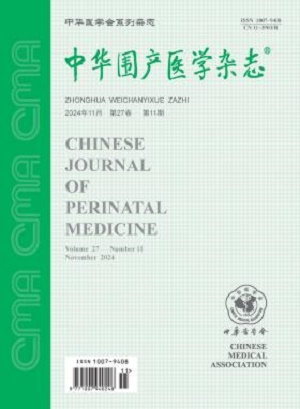Activation of mammalian target of rapamycin signaling pathway in placental tissues of gravidas with gestational diabetes mellitus
Q4 Medicine
引用次数: 1
Abstract
Objective To investigate the activation of mammalian target of rapamycin (mTOR) signaling pathway in placental tissues of gestational diabetes mellitus (GDM) women and in JEG3 cells after high glucose treatment. Methods Placental tissues were collected from 60 singleton pregnant women at term, who underwent elective cesarean section in Peking University First Hospital from December 2016 to June 2017, including 30 GDM women (GDM group) and 30 normal glucose tolerance (NGT) women (NGT group). Expressions of mTOR, Rictor, Raptor, S6 kinase (S6K) and phosphorylated-S6K (p-S6K), which were mTOR signaling pathway-related molecules in those placental tissues were detected by real-time fluorescence quantitative polymerase chain reaction, Western blotting and immunohistochemistry. At the same time, JEG3 cells were treated with glucose of different concentrations (5.5, 10.0, 15.0, 25.0 and 50.0 mmol/L) for 24 h, and the expressions of mTOR, S6K and p-S6K were detected by Western blotting. Two independent samples t-test, one-way analysis of variance test and Spearman correlation analysis were used for statistical analysis. Results Compared with the NGT group, the pre-pregnancy body mass index(BMI), neonatal birth weight, fasting blood glucose(FBG), and 1 h and 2 h post-load blood glucose in oral glucose tolerance test (OGTT) of the GDM group were significantly increased [pre-pregnant BMI: (21.6±2.7) vs (23.4±3.5) kg/m2, t=-2.192; neonatal birth weight: (3 337.5±347.7) vs (3 618.3±580.9) g, t=-2.727; FBG: (4.6±0.4) vs (5.2±0.8) mmol/L, t=-3.947; 1 h glucose level: (7.4±1.2) vs (9.6±1.9) mmol/L, t=-5.332; 2 h glucose level: (6.3±1.0) vs (8.1±1.5) mmol/L, t=-5.314; all P<0.05]. The mRNA expressions of mTOR, Rictor and Raptor were significantly higher in the GDM group than in the NGT group (0.051±0.015 vs 0.031±0.011, t=-5.635; 0.038±0.017 vs 0.026±0.010, t=-3.485; 0.036±0.012 vs 0.025±0.011, t=-3.312; all P<0.05). The expression of mTOR, Rictor, Raptor and p-S6K protein in the GDM group were enhanced as compared with those in the NGT group (0.834±0.432 vs 0.386±0.361, t=-2.249; 0.589±0.236 vs 0.262±0.075, t=-3.726; 0.767±0.345 vs 0.323±0.109, t=-3.472; 1.847±1.025 vs 0.834±0.432, t=-2.575; all P<0.05). The results of immunohistochemistry also showed that the p-S6K in the placental tissues of the GDM group was higher than that of the NGT group (0.29±0.09 vs 0.18±0.08, t=-3.122, P=0.004). The expressions of mTOR protein (0.190±0.085, 0.301±0.089, 0.419±0.065, 0.562±0.108, 0.412±0.058, F=18.351, P<0.05) and p-S6K protein (0.753±0.150, 1.146±0.289, 2.148±0.188, 2.248±0.115, 2.134±0.214, F=66.242, P<0.05) in JEG3 cells treated with different concentrations of glucose (5.5, 10.0, 15.0, 25.0 and 50.0 mmol/L) were significantly different and increased with increasing concentrations of glucose (r=0.314, P=0.035; r=0.457, P=0.002). Conclusions The up-regulated expressions of mTOR signaling pathway-related molecules in GDM placenta and high glucose-treated trophoblast cells (JEG3 cells) indicate a possible correlation between mTOR signaling pathway and GDM. However, the specific mechanisms need further study. Key words: Diabetes, gestational; Placenta; Mammalian target of rapamycin, serine/threonine kinases; Signal transduction妊娠期糖尿病孕妇胎盘组织雷帕霉素信号通路靶点的激活
目的研究哺乳动物雷帕霉素靶点(mTOR)信号通路在妊娠期糖尿病(GDM)妇女胎盘组织和高糖治疗后JEG3细胞中的激活。方法收集2016年12月至2017年6月在北京大学第一医院择期剖宫产的60例足月单胎孕妇的胎盘组织,其中GDM组30例,糖耐量正常组30例。采用实时荧光定量聚合酶链反应、蛋白质印迹和免疫组织化学方法检测mTOR信号通路相关分子mTOR、Rictor、Raptor、S6激酶(S6K)和磷酸化-S6K(p-S6K)在胎盘组织中的表达。同时,用不同浓度(5.5、10.0、15.0、25.0和50.0 mmol/L)的葡萄糖处理JEG3细胞24小时,通过蛋白质印迹检测mTOR、S6K和p-S6K的表达。采用两个独立样本t检验、单向方差分析和Spearman相关分析进行统计分析。结果与NGT组比较,GDM组口服糖耐量试验(OGTT)负荷后1小时和2小时血糖显著升高[孕前BMI:(21.6±2.7)vs(23.4±3.5)kg/m2,t=-2.192;新生儿出生体重:(337.5±347.7)vs(361.3±580.9)g,t=-2.727;FBG:(4.6±0.4)vs(5.2±0.8)mmol/L,t=-3.947;1小时血糖水平:(7.4±1.2)vs(9.6±1.9)mmol/L;t=-5.332;2小时血糖水平(6.3±1.0)vs(8.1±1.5)mmol/L,t=-5.314;mTOR、Rictor和Raptor的mRNA表达在GDM组中显著高于NGT组(0.051±0.015 vs 0.031±0.011,t=-5.635;0.038±0.017 vs 0.026±0.010,t=-3.485;0.036±0.012 vs 0.025±0.011;t=-3.312;均P<0.05),与NGT组相比,GDM组Raptor和p-S6K蛋白增强(0.834±0.432 vs 0.386±0.361,t=-2.249;0.589±0.236 vs 0.262±0.075,t=-3.726;0.767±0.345 vs 0.323±0.109,t=-3.472;1.847±1.025 vs 0.834±.432,t=-2.575;均p<0.05)NGT组(0.29±0.09vs 0.18±0.08,t=-3.122,P=0.004)。mTOR蛋白(0.190±0.085,0.301±0.089,0.419±0.065,0.562±0.108,0.412±0.058,F=18.351,P<0.05)和P-S6K蛋白(0.753±0.150,1.146±0.289,2.148±0.188,2.248±0.115,2.134±0.214,F=66.242,P<0.05)在不同浓度葡萄糖(5.5,10.0,15.0,25.0和50.0mmol/L)处理的JEG3细胞中的表达分别为:结论mTOR信号通路相关分子在GDM胎盘和高糖处理的滋养层细胞(JEG3细胞)中的表达上调表明mTOR信号途径可能与GDM有关。然而,具体机制还需要进一步研究。关键词:糖尿病,妊娠期;胎盘;雷帕霉素、丝氨酸/苏氨酸激酶的哺乳动物靶点;信号转导
本文章由计算机程序翻译,如有差异,请以英文原文为准。
求助全文
约1分钟内获得全文
求助全文
来源期刊

中华围产医学杂志
Medicine-Obstetrics and Gynecology
CiteScore
0.70
自引率
0.00%
发文量
4446
期刊介绍:
Chinese Journal of Perinatal Medicine was founded in May 1998. It is one of the journals of the Chinese Medical Association, which is supervised by the China Association for Science and Technology, sponsored by the Chinese Medical Association, and hosted by Peking University First Hospital. Perinatal medicine is a new discipline jointly studied by obstetrics and neonatology. The purpose of this journal is to "prenatal and postnatal care, improve the quality of the newborn population, and ensure the safety and health of mothers and infants". It reflects the new theories, new technologies, and new progress in perinatal medicine in related disciplines such as basic, clinical and preventive medicine, genetics, and sociology. It aims to provide a window and platform for academic exchanges, information transmission, and understanding of the development trends of domestic and foreign perinatal medicine for the majority of perinatal medicine workers in my country.
 求助内容:
求助内容: 应助结果提醒方式:
应助结果提醒方式:


